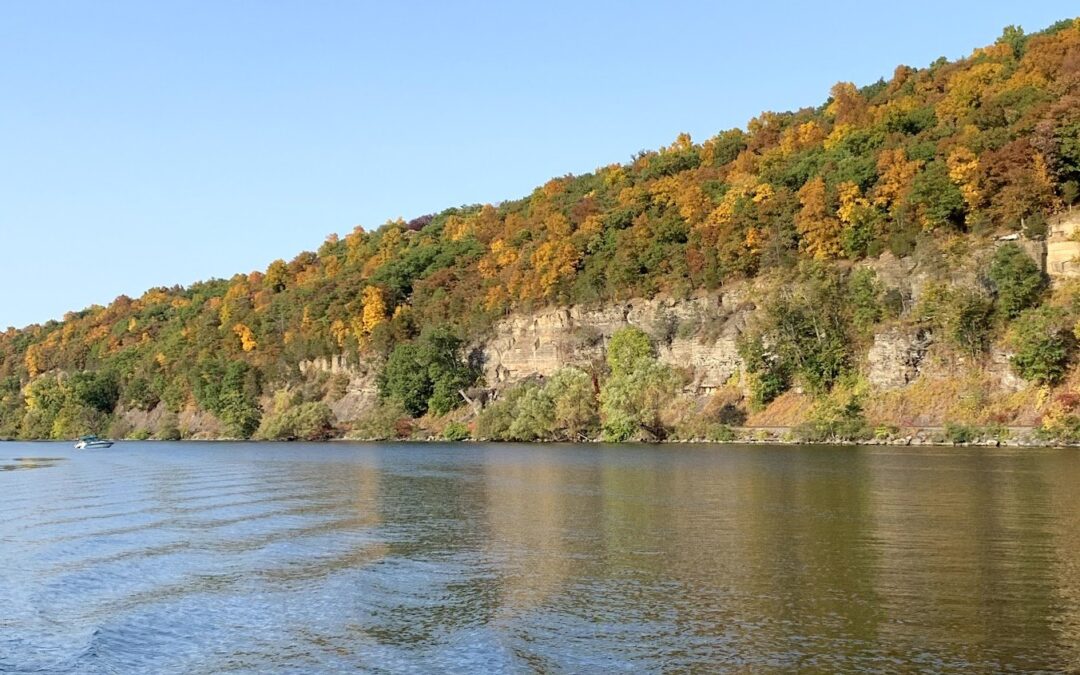A sure sign that summer is ending around Cayuga Lake is the migration of osprey to their winter homes in South America. In early September, osprey leave the nest they raised chicks in over summer and take a nearly 4,000 mile flight to warmer weather in places like Argentina and Brazil.

In these macro-invertebrate lessons, students sift through containers of freshly gathered stream water containing decomposing leaves, sticks, mud and … critters! As they do so, they identify the important aquatic insects, flies and worms which serve to indicate the health of the streams in which they’ll soon be releasing their trout.

Osprey nest in the Cayuga inlet on a wooden platform built by NYSEG, New York State Electric and Gas Co.
Cayuga Lake is home to nearly 150 osprey pairs that can often be found on wooden platforms installed by NYSEG, New York State Electric and Gas Company, all around the lake. These platforms were put in place to divert osprey from nesting on telephone poles, while still ensuring a home for these birds of prey who indicate a healthy ecosystem around Cayuga Lake. Osprey return to the same nest year after year and reunite with the same mate after their winter migration. On Cayuga Lake, osprey’s first sighting in the year is around April, and typically by May pairs will have anywhere from one to four eggs in their nest.
It’s an amazing experience getting to watch osprey grow up around the lake, something that has been captured through Discover Cayuga Lake’s Osprey Eco Cruises. Slowly throughout the summer, guests watch chicks heads pop up out of the nest and admire as the adult female osprey dutifully stands on the nest, guarding her chicks from predators like Great Horned Owls and Bald Eagles. If guests are lucky, they can watch as the adult male osprey scoops a fish out of the water using their long, hooked talons and brings it to the nest for the family to feast.

Male osprey bringing a fish to a chick in the nest. Photo by Candace Cornell
Around July, after two months in the nest, juvenile osprey will fledge and practice flying and fishing on their own before their big migration south in September. For the past few weeks, cruise guests have had the good fortune of seeing many young osprey flying around the lake and diving for fish. The fledglings are similar in size and appearance to the adults, with white plumage below and dark plumage on top, however they are noticeable by white tips on the feathers of their back and upper wings. It’s such a short window between fledging the nest and migration, and if you make your way to the lake in the next week or two, you might be lucky enough to see the remaining osprey soaring above.
But as fewer osprey are being spotted around the lake and cool, crisp air is being felt in the morning and evening time, it is clear we are in a time of transition from one season to the next. Discover Cayuga Lake’s schedule reflects this seasonal transition as well, as the late afternoon Eco Cruise transitions from an Osprey Cruise to a Fall Foliage Cruise.
During the Fall Foliage Eco-Cruise, guests can admire the lush foliage along the lake shore as the trees leave’s begin to change into a colorful display. It’s one thing to go leaf-peeping by car or otherwise, but being in the middle of the lake on a boat while surrounded by the rolling hills from south to north is a Finger Lakes experience that is hard to beat.
The Fall Foliage Eco-Cruise will take place weekly in September and October. Narrators will talk about the history and ecology of Cayuga Lake while also viewing the changing colors and discussing the fall harvest so abundant around the Finger Lakes. To book your reservation for the Fall Foliage Eco-Cruise, visit our online booking page where you can also find out information about more of our boat cruises at Discover Cayuga Lake.

Changing of colors in the trees along the West shore of Cayuga Lake.

